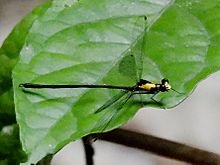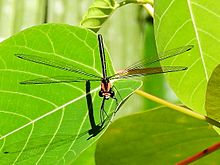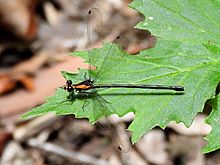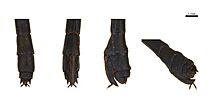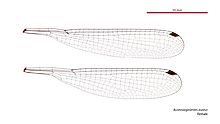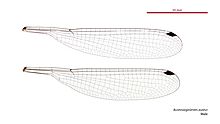Tropical flatwing facts for kids
Quick facts for kids Tropical flatwing |
|
|---|---|
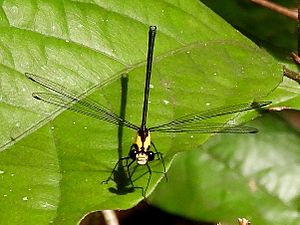 |
|
| Male, Mount Lewis, Queensland | |
| Conservation status | |
| Scientific classification | |
 |
The Tropical flatwing (Austroargiolestes aureus) is a fascinating insect that lives in Australia. It is a type of damselfly, which are close relatives of dragonflies. This special insect is found only in the wet rainforests of north-eastern Queensland. It loves to live near streams and other fresh water.
Contents
About the Tropical Flatwing
The Tropical flatwing is known for its unique look and how it rests. It belongs to a family of damselflies called Megapodagrionidae. These damselflies are special because they rest with their wings spread out wide. Most other damselflies fold their wings back over their bodies when they are not flying.
What Does it Look Like?
The Tropical flatwing is a medium to large-sized damselfly. It has a striking appearance with its black and yellow colors. Unlike some other insects, it does not have a powdery coating called "pruinescence" on its body. This means its colors are usually bright and clear.
Where Does it Live?
This damselfly is endemic to north-eastern Queensland, Australia. This means it is found nowhere else in the world! It prefers to live in rainforests, especially near streams. These streams provide the perfect home for its young, which live in the water.
What is a Damselfly?
Damselflies are insects that belong to a group called Odonata, which also includes dragonflies. They have long, slender bodies and two pairs of strong, clear wings. Damselflies are often smaller and more delicate than dragonflies. They also hold their wings differently when resting.
What Do They Eat?
Both adult damselflies and their young are predators. Adult Tropical flatwings fly around and catch small insects in the air. They use their excellent eyesight to spot their prey. Their strong legs help them grab and hold onto their food.
Life Cycle of a Damselfly
The life cycle of the Tropical flatwing, like other damselflies, has three main stages:
- Egg: Female damselflies lay their eggs in or near water. They often place them on water plants.
- Nymph: The eggs hatch into young damselflies called nymphs. These nymphs live underwater. They have special gills to breathe in the water. Nymphs are also predators, eating tiny water creatures. They grow by shedding their skin many times.
- Adult: When a nymph is ready, it crawls out of the water. It then sheds its skin one last time to become an adult damselfly. The adult damselfly can fly, find a mate, and lay eggs to start the cycle again.
Why Are They Important?
Damselflies like the Tropical flatwing play an important role in their ecosystem. They help control populations of smaller insects. They also serve as food for larger animals, like birds and fish. Their presence can also be a sign of a healthy environment, especially clean water.
Gallery



